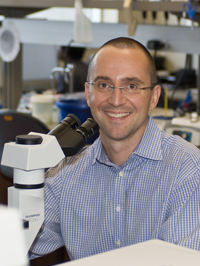A new pan-Canadian review led by a University of British Columbia clinician-scientist provides guidance on a deadly, but rare, disease that is potentially curable if identified early.
Severe combined immunodeficiency disease (SCID), known as the “bubble boy disease” in the 1970s, is treatable with a stem cell transplant, gene therapy and other treatments if identified at birth or soon after.
“This review informs physicians who may treat newborns in their practice (e.g., family physicians, obstetricians, pediatricians) on how to approach patients and counsel families who are faced with an abnormal screen,” writes lead author Stuart Turvey, a Professor in the Department of Pediatrics and investigator at BC Children’s Hospital.
The review, published in CMAJ, includes features to watch for in newborns with repeated illnesses, information on screening and diagnosis, treatments for the disease as well as the approach and support for parents of babies who may receive a positive screen, including false positives which do not mean the newborn has SCID.
The death rate for severe combined immunodeficiency disease is at least 30 per cent, with infection causing 60 per cent of deaths in infants. Ontario was the first jurisdiction in Canada to offer screening for severe combined immunodeficiency disease in 2013 as part of the heel prick test performed soon after birth. Screening has been expanded to the Maritime provinces and will be implemented in several other provinces.
“The opportunity to identify severe combined immunodeficiency early in life has transformed outcomes for this otherwise fatal condition. Introducing this assay into newborn screening programs throughout Canada has the potential to save lives and prevent suffering of patients and families affected by this condition,” the authors conclude.
